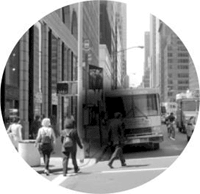

| Age-related
Macular Degeneration (AMD) is an eye disease that destroys central vision by
damaging the macula, a thin layer of nerve cells that lines most of the inside
of your eyeball and is part of the retina. Nerve cells in the retina detect
light and send signals to the brain of what your eye sees. The macula is near
the center of the retina at the back of the eyeball and provides the clear,
sharp, central vision that you use for focusing on what is in front of you. Because AMD does not affect side vision, it does not lead to total blindness. However it will cause central vision loss, the most important part of your vision. Central vision lets you identify shapes, colors, and details sharply and clearly and lets you see what is directly in front of you. Therefore, in its advanced stages, AMD can be devastating. It most commonly affects people in their 60s or older and is the leading cause of vision loss and legal blindness in people over age 65 in the United States. "Legal blindness" is a government term and it only means vision of 20/200 or worse. It is a term that the government applies to ANY eye disorder that results in an individual not being able to read normal print. It does NOT mean TOTAL blindness. There are two types of age-related Macular Degeneration and either type may affect one or both eyes. Dry age-related Macular Degeneration is the most common form (90% of cases) and does not usually cause severe vision loss. Central vision slowly becomes dimmer or blurred as the person gets older. Wet age-related Macular Degeneration is much less common (10% of cases). It can damage the macula quickly and cause rapid and severe loss of central vision. There are only a few ways to treat AMD. Glasses cannot correct the problem. If an area of the macula breaks down and stops functioning, the person's central field of vision will have a blank or dark spot that will never go away. Vision loss from AMD cannot be reversed. It can only hope to be maintained at its current stage. In addition, there is no cure or treatment for dry age-related Macular Degeneration (dry AMD) at this time. Because vision loss happens very slowly, people afflicted with dry AMD may not have significant problems with their vision for many years. For example, it may affect only one eye, and a person can compensate with the unaffected eye. A person with dry AMD should follow his or her doctor's recommendations for regular exams and monitoring the condition at home (such as viewing an Amsler Grid). Dry AMD may sometimes develop into wet AMD, a more serious form of the disease. Wet AMD can sometimes be treated with laser surgery or photodynamic therapy (PDT). Other types of surgery and treatments using radiation or medications are being investigated, but these are considered experimental and are not part of standard treatments. However, people with reduced vision can use vision aids, develop a support network, and receive counseling and training to help them cope with their reduced vision, effectively use the vision they have, and maintain their quality of life. If you have already experienced a vision loss from AMD, your doctor will conduct a low-vision evaluation that will help you and your doctor find ways to make the best use of your remaining vision. It may include suggestions for counseling and training on dealing with reduced vision to help you maintain your quality of life as much as possible. Contact your eye care professional for more information. If you are experiencing vision loss and think you may have AMD, please seek the opinion of an eye care professional as soon as possible.
|